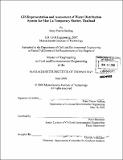| dc.contributor.advisor | Peter Shanahan. | en_US |
| dc.contributor.author | Harding, Mary Pierce | en_US |
| dc.contributor.other | Massachusetts Institute of Technology. Dept. of Civil and Environmental Engineering. | en_US |
| dc.coverage.spatial | a-th--- | en_US |
| dc.date.accessioned | 2008-12-11T18:48:22Z | |
| dc.date.available | 2008-12-11T18:48:22Z | |
| dc.date.copyright | 2008 | en_US |
| dc.date.issued | 2008 | en_US |
| dc.identifier.uri | http://hdl.handle.net/1721.1/43901 | |
| dc.description | Thesis (M. Eng.)--Massachusetts Institute of Technology, Dept. of Civil and Environmental Engineering, 2008. | en_US |
| dc.description | Includes bibliographical references (leaves 48-50). | en_US |
| dc.description.abstract | ArcGIS is used to analyze water access in Mae La, Thailand, home to 45,000 residents living as refugees in a temporary camp. Drinking water for the shelter is supplied at public tap stands while water for hygienic purposes such as bathing and laundry is available via covered rope-pump wells which reach shallow ground water; stream and river surface water; and hand-dug wells. In all, 7,117 homes were identified using Google Earth and the corresponding proximity to the nearest tap stand and rope-pump well was calculated. ArcGIS was used together with an EPANET water-distribution model created by Rahimi (2008) to evaluate the predicted daily volume of drinking water available per home. Overall this research shows that the vast majority of residents in Mae La have sufficient access to water. Homes located further than 115 meters from a tap stand, located further than 180 meters from a rope-pump well, or having access to less than 50 liters of water per day were considered a cause for concern. Approximately one in four homes met these criteria. Only 5% of homes are located more than 115 meters from a tap stand. Approximately 14% of homes did not meet the rope-pump proximity criterion, and 15% of homes did not meet the available volume criterion. The tap-stand proximity results provide a much higher degree of confidence compared to the other results. Alternative sources for hygienic water besides rope-pump wells exist, suggesting the number of homes with sufficient access to hygienic water is likely underestimated. Flow rates, predicted by the EPANET model, are highly dependent on the elevation of distribution system infrastructure points (e.g. storage tanks and tap stands), which are difficult to determine accurately. | en_US |
| dc.description.abstract | (cont.) Thus, while the final results show one in four homes are a cause for concern, the reliability of the rope-pump well proximity assessment and volume per home assessment is insufficient, and the findings could be overly pessimistic. | en_US |
| dc.description.statementofresponsibility | by Mary Pierce Harding. | en_US |
| dc.format.extent | 57 leaves | en_US |
| dc.language.iso | eng | en_US |
| dc.publisher | Massachusetts Institute of Technology | en_US |
| dc.rights | M.I.T. theses are protected by
copyright. They may be viewed from this source for any purpose, but
reproduction or distribution in any format is prohibited without written
permission. See provided URL for inquiries about permission. | en_US |
| dc.rights.uri | http://dspace.mit.edu/handle/1721.1/7582 | en_US |
| dc.subject | Civil and Environmental Engineering. | en_US |
| dc.title | GIS representation and assessment of water distribution system for Mae La Temporary Shelter, Thailand | en_US |
| dc.title.alternative | Geographic information systems representation and assessment of water distribution system for Mae La Temporary Shelter, Thailand | en_US |
| dc.type | Thesis | en_US |
| dc.description.degree | M.Eng. | en_US |
| dc.contributor.department | Massachusetts Institute of Technology. Department of Civil and Environmental Engineering | |
| dc.identifier.oclc | 263871971 | en_US |
